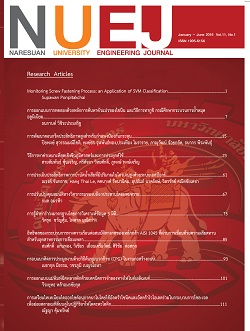อิทธิพลของกระบวนการทางความร้อนที่มีผลต่อการเชื่อมเหล็กกล้า AISI 1045 ด้วย ความเสียดทาน สำหรับอุตสาหกรรมการเชื่อมเพลา
Main Article Content
Abstract
บทคัดย่อ – งานวิจัยนี้มีวัตถุประสงค์เพื่อศึกษาอุณหภูมิของการอบอ่อนเหล็กกล้า AISI 1045 หลังการเชื่อมด้วยความเสียดทาน เพื่อให้เข้าใจถึงอิทธิพลอุณหภูมิของการอบอ่อน ที่มีผลต่อความแข็งแรงและความแข็งของรอยเชื่อม รวมถึงโครงสร้าง มหภาคและโครงสร้างจุลภาคของรอยเชื่อม การทดลองเชื่อมกระทำภายใต้เวลาเชื่อม และความดันเชื่อมที่แตกต่างกัน ซึ่งผลการทดลองภายใต้เงื่อนไขการเชื่อมที่แตกต่างกันถูกนำมาวิเคราะห์ความต้านทานแรงดึง, ความแข็งตามแนวเชื่อม, โครงสร้างมหภาค, และโครงสร้างจุลภาค ผลการทดลองชิ้นงานที่ผ่านการอบอ่อนที่อุณหภูมิ 790, 870,และ 950 องศาเซลเซียส หลังการเชื่อมด้วยความเสียดทานนั้น พบว่าชิ้นงานที่ผ่านการอบอ่อนที่อุณหภูมิ 790 องศาเซลเซียส มีความต้านทานแรงดึงและความแข็งบริเวณรอยเชื่อมสูงที่สุด และจากการตรวจสอบด้วยกล้องจุลทรรศน์ พบว่าที่บริเวณรอยเชื่อมมีการเติบโตของเกรนเล็กกว่าทั้งสองอุณหภูมิอบอ่อน มีโครงสร้างเป็น เฟอร์ไรต์ (Ferrite), และเพิรไลต์ (Pearlite) ในส่วนของชิ้นงานที่ผ่านการอบอ่อนที่อุณหภูมิ 870,และ 950 องศาเซลเซียส มีความต้านทานแรงดึงและความแข็งบริเวณรอยเชื่อมไม่ต่างกันมาก โครงสร้างที่เกิดขึ้นบริเวณรอยเชื่อมเป็น, เฟอร์ไรต์, และเพิรไลต์ แต่มีขนาดเกรนที่โตกว่า อุณหภูมิ 790 องศาเซลเซียส เกิดจากออสเตนไนต์ (Austenite) ขยายตัวได้มากทำให้โครงสร้างสุดท้ายมีเกรนโตไปด้วย
Abstract – The purpose of this analysis is to investigate the effect of an annealing temperature of AISI 1045 after friction welding. In order to understand the effect of this annealing temperature on strength and hardness of welded area including its macrostructure and microstructure, welding experiments under limited time and welding pressure are applied. Welding experiments under different condition are analyzed for tensile strength, hardness on welded area, macrostructure, and microstructure. After workpiece has been through annealing at the temperature of 790°c, 870°c, and 950 °c, the experiment reveal that an annealing temperature of 790°c has the highest tensile strength and hardness on welded area. Also, microscopic examination finds that welded area has minimal grain expansion compare to the other two annealing temperature. It has Ferrite and Pearlite structure. In term of annealing temperature at 870°c and 950°c, there is a minor different in both tensile strength and hardness around welded area. Structure of welded area is the same Ferrite and Pearlite but with bigger grain size than at 790°c. Wide expansion of Austenite creates big grain size for the last structure.


